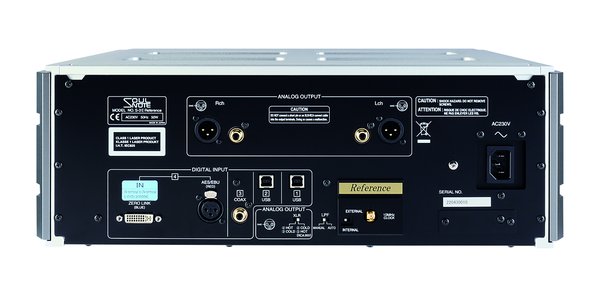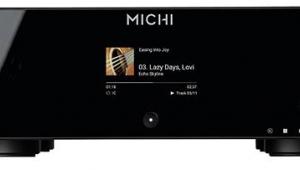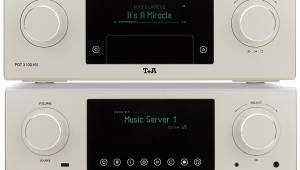Soulnote S-3 Reference

 Still big in Japan, the SACD takes pride of place in Soulnote's 'ultimate digital playback system' that also includes the option of digital filterless conversion and external clocking
Still big in Japan, the SACD takes pride of place in Soulnote's 'ultimate digital playback system' that also includes the option of digital filterless conversion and external clocking
With Soulnote having already proved its analogue mettle in these pages with the E-2 phono preamp , does the brand have similar prowess with digital? And not just with CDs, for this S-3 flagship is a fully-fledged SACD player.
At £19,900, the S-3 Reference, to give its full name, may come in at the upper reaches of integrated SACD players but it significantly undercuts many high-end two-box solutions. Aside from the choice of silver or black, there is only one other thing to consider, the optional X-3 Clock Generator at £4500 (not supplied for this review). Also available is the identically featured D-3 DAC for £1000 less, but it seems a false economy to forego the transport even if you already have one.
 Dual PSUs [far left and right] feed the
digital and analogue sections of both left and
right channels. Two ESS9038PRO DACs are
employed per channel, feeding a proprietary
‘Type-R’ balanced output stage [bottom]. The
SACD/CD transport has a tray loader [top]
Dual PSUs [far left and right] feed the
digital and analogue sections of both left and
right channels. Two ESS9038PRO DACs are
employed per channel, feeding a proprietary
‘Type-R’ balanced output stage [bottom]. The
SACD/CD transport has a tray loader [top]
Master Of The Arts
Massive at 454x170x393mm (whd) and heavy at 27kg, the S-3 is a superbly built unit that comes with a handsome wooden plinth measuring 475x410mm. I couldn't say I heard a difference when I removed it and put the S-3 onto my default Acapella platform, but it sure looks nice. Otherwise the S-3 rests on three rather than four feet - actually massive 'grounding spikes' - and is very easy to level.
Soulnote has mastered the art of blending a lot of features into a fascia that looks minimalist. The trompe l'oeil? All of the details are tiny. I counted no fewer than 15 LED indicators in addition to the numerical display, and nine buttons for transport, input and filter selection, plus power on/off. One might be tempted to dive straight in without looking at the manual but this is necessary to understand the various filters on offer.
To the left, in the row beneath the centrally positioned disc tray, are lights to indicate which filters are chosen, polarity inversion, and which of the digital inputs are in use. Relevant buttons are positioned below the LEDs. On the righthand side, above the transport controls and open/close, are lights to indicate CD or SACD, selected playback mode, eg, repeat, and either external clock or incoming sampling frequency.
As expected of a single-box player that can be used as a DAC, the S-3's back panel is comprehensively equipped. In addition to a choice of balanced XLR or single-ended RCA analogue outputs, the digital inputs include a proprietary multi-pin 'Zero Link' and, for the rest of us, there are AES/EBU via XLR, conventional coaxial, and a couple of USB-B inputs. Conveniently, the (analogue) XLR pin configuration may be flipped via a switch on the rear, alongside manual or automatic selection of the S-3's low-pass filter, and a final switch that defaults to the internal clock or selects the optional external clock, alongside the appropriate input.
Guessing Game
What might prove a boon or a distraction are the filters. I say that because there was no predictability - some discs sounded better with the FIR filter, others with NOS (no filter), including those from the same labels and artists. But as the filters are switchable from the remote it's not the burden it could have been, and is something to add to polarity inversion if you're the sort who can't resist fiddling around with settings rather than settle for defaults.
The S-3's NOS (non-oversampling) mode applies only to CD playback - it's not accessible with SACD - and its pros and cons are described in PM's Lab Report. What surprised me were the results, an SHM-CD and a gold CD showing less variance than 'plain vanilla' CDs - but even that wasn't consistent. How far back in the mastering chain one has to go to find out why I cannot say, but it's up to the listener's own penchant for A/B switching to decide which is best.
All this reflects the fact that while Soulnote employs two ESS9038PRO DACs per channel here, its decision to opt for just one of the in-built filters (seven are baked into this tried-and-tested DAC chip) and a NOS alternative, speaks volumes for the uniqueness of the product. Massive linear power supplies are fitted, with independent L/R grounding, while the 'Type-R non-NFB' analogue output circuit is a two-stage, fully discrete affair with the first, unity gain, stage performing I-to-V conversion on the current output of the DAC(s).
Another feature is the switchable LPF (low-pass filter), the impact of which depends as much on the behaviour of one's loudspeakers and room. Suffice it to say, the S-3 allows you to fine-tune the sound in numerous ways, and it will benefit your CDs - normal, gold, what-have-you - such that they come close to sounding as good as the SACDs, especially SHM CDs.
 Digital inputs are on coaxial, USB-B (x2), AES/EBU and a proprietary ‘Zero
Link’ port for use with compatible network transports. An external 10MHz clock is
also supported. Outputs are on on RCAs and configurable, balanced XLRs
Digital inputs are on coaxial, USB-B (x2), AES/EBU and a proprietary ‘Zero
Link’ port for use with compatible network transports. An external 10MHz clock is
also supported. Outputs are on on RCAs and configurable, balanced XLRs
Have A Little Faith
Used in balanced mode, the S-3's operation was hard to criticise. The remote also operates other Soulnote hardware, which might explain why some functions are missing - eg, power on/off and polarity inversion, but those are hardly worth mourning. It had no trouble choosing between SACDs and CDs, but does take its time assessing which type of disc has been inserted, not unlike PS Audio's PerfectWave transport .
Note that switching off the display, leaving only the red power-on indicator, made an audible change for the better: quieter, if you can believe that. Add that to the two filter choices and what follows makes more sense. Before focusing on SACDs, I wanted to deal with CDs as they constitute the bulk of most libraries, even for SACD devotees. I listened to five different editions of the same album, to test the filter/no filter options.
Before listing them, I do realise that they may have come from different production masters, but their value here was in the formats. Blind Faith's eponymous debut from 1969 is one of my all-time Top 10 albums, so I played, in ascending order of sound quality, the 1986 'normal' CD [RSO 825 094-2], the 2001 Polydor Deluxe Edition CD [314 549 529-2], Mobile Fidelity's AAD UltraDisc gold CD pressed in Japan [UDCD 507], the Japanese Ultimate HQ MQA CD [Polydor UICY-40175] and the hands-down best one of all, the SHM Platinum CD [Universal UICY-40013].
Weight And Depth
In every case, use of the S-3's FIR and NOS filters allowed me to close the gaps between them, even if I had no overall preference. The ear-opener, however, was playing the worst and then the best, the 1986 CD followed by the SHM, which exposed the scale of the gap vis-à-vis the formats. The weight and depth of Ginger Baker's drumming on the opening track, 'Had To Cry Today', increased with the NOS filter as did the differentiation between the guitar and bass when following the same lines - more so when applied to the 1986 CD, less so for the superior SHM Platinum.
Better still for 'hearing' the S-3's filters were the more delicate moments in 'Can't Find My Way Home', the two acoustic guitars which open the track both meshing and competing at the same time. I also focused on, of all things, the trashy cymbal, which accented the track and contrasted on multiple levels with the toms, their textures growing more lifelike with the FIR filter in tow. But I must emphasise again that there are no hard and fast rules: you have to select NOS or FIR by ear.
Dispensing with CDs for SACDs, of which I don't have one for Blind Faith, I was able to compare my current go-to reference SACD, Dr John's In The Right Place [Analogue Productions CAPA 006 SA] with Mobile Fidelity's gold CD [UDCD 619]. As superb as is the latter, especially when compared to the standard CD on Atlantic, the SACD lifted every parameter of the sound.
Making Space
This disc landed on the top of my reference pile for a number of qualities, but most notable are the attack, the bass control, and the sounds of Dr John's distinctive vocals and star instrument: piano. 'Such A Night' is always irresistible, but the S-3 performed something to an unexpected degree. It constructed a flawless, seamless soundstage with - and I know you're going to question my sanity for saying this - an immediately palpable sense of atmosphere, not just open space.
Within the presentation, the backing vocalists stage left sounded positively angelic, with the bla-a-arty trumpet evoking real New Orleans soul. Let me not wax too insanely glorious about this because the SACD sounds fabulous even via my small desktop system's Sony Blu-ray player. But through the S-3? Something akin to magic.
It was the same with John Prine's self-titled debut [Analogue Productions CAPA 004 SA], its unplugged acoustic guitar exposing a brittleness in the regular CD. The way the S-3 matches natural tonality with a soundstage and sense of space utterly free of artifice is the party trick. The last time I heard an SACD sounding this uncoloured and authentic was via dCS's four-box Vivaldi stack , for the price of an Aston Martin.
Influencer
All that was left to make me want an S-3 was to try it as a DAC with three dissimilar transports: the circa-1989 Marantz DA-12, the PS Audio PerfectWave and a coaxial feed from my trusty Marantz DV-8300. This listening session reinforced my belief that DACs exercise greater influence on sound than transports, which adds to the appeal of Soulnote's DAC-only D-3. However, it also makes the extra £1000 for the S-3 even more of a bargain...
Hi-Fi News Verdict
Because I'm predisposed toward SACD, one might presume that I'm going 'easy' on the Soulnote S-3. But having five SACD players to hand (if not a £100k-plus deck), I am happy to declare that this unit not only exemplifies why SACD is the finest physical digital source yet, it also further elevates CD sound to narrow the gap between digital and analogue. Which is all one could want. This player is an utter joy.
Sound Quality: 89%



















































